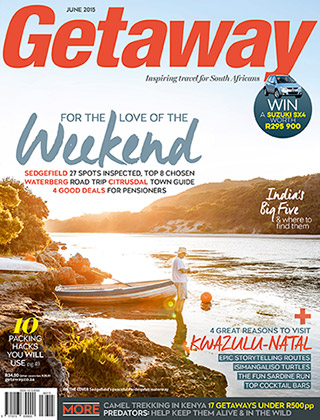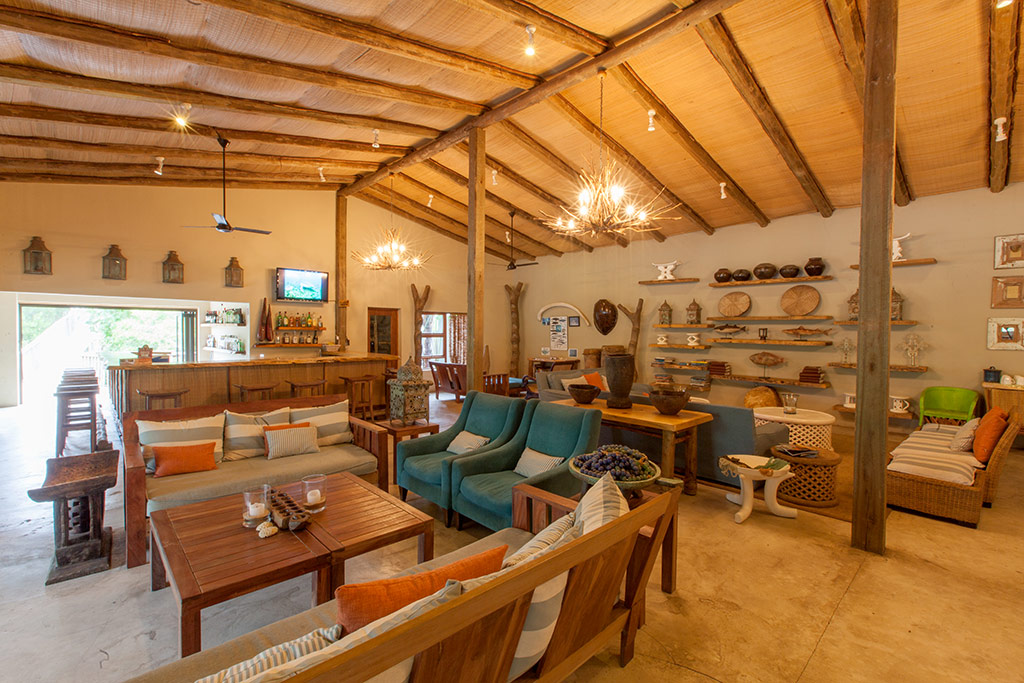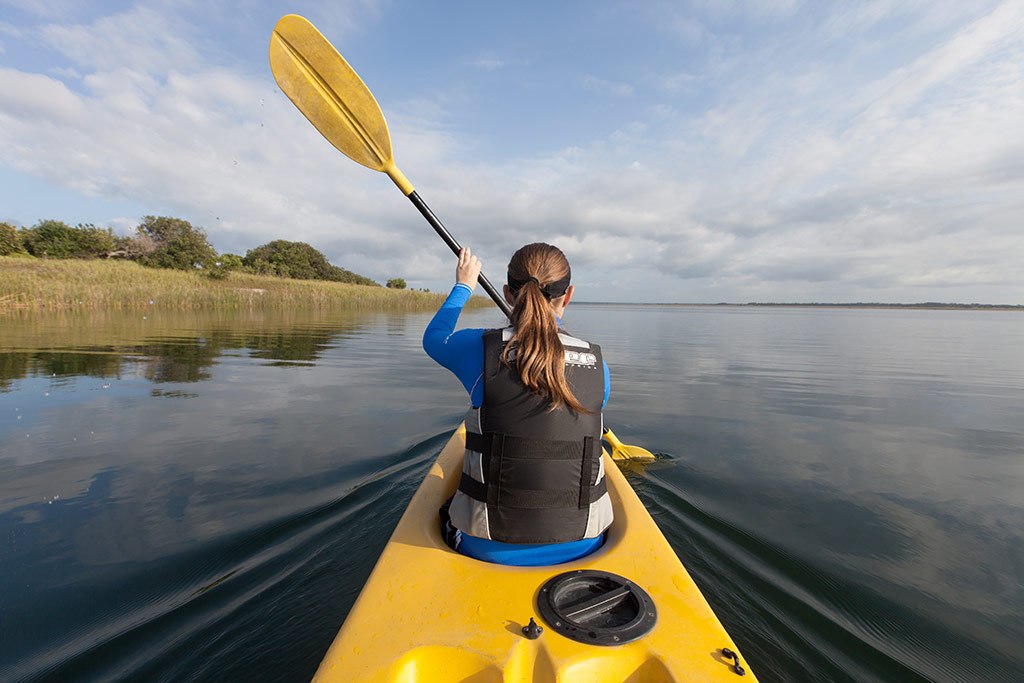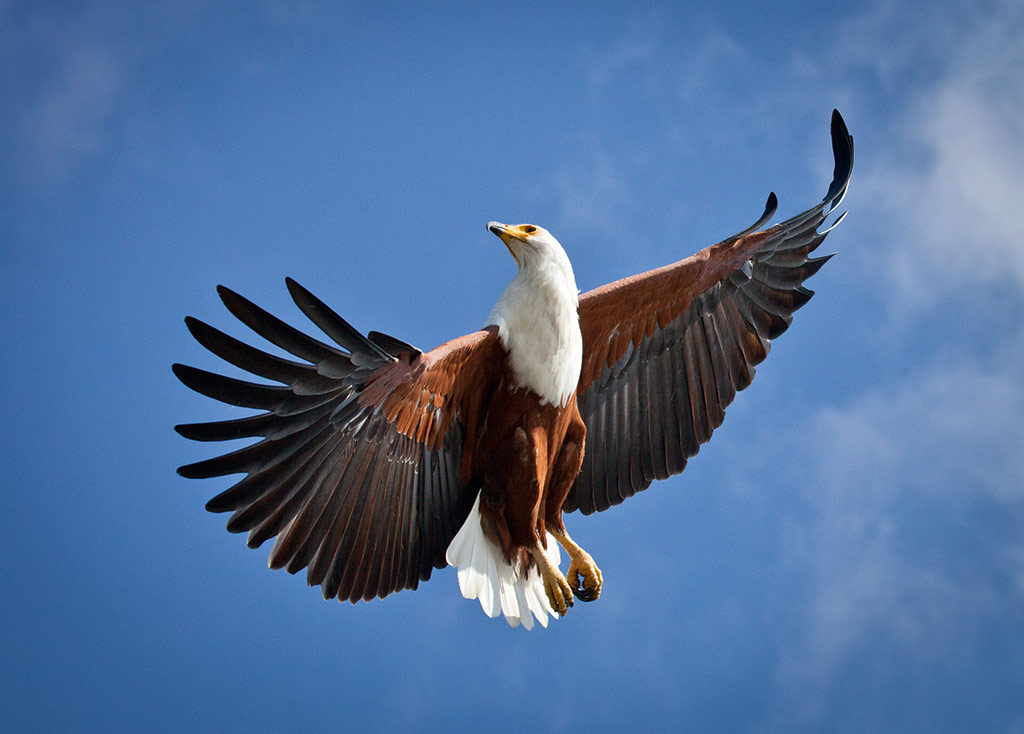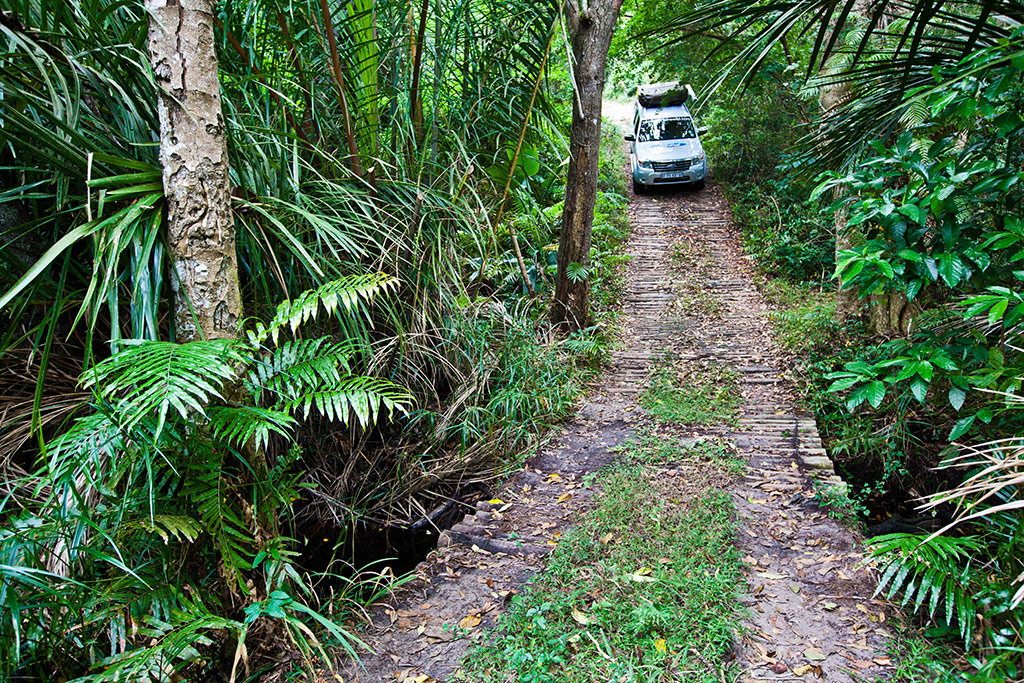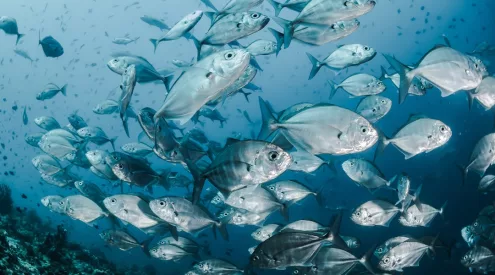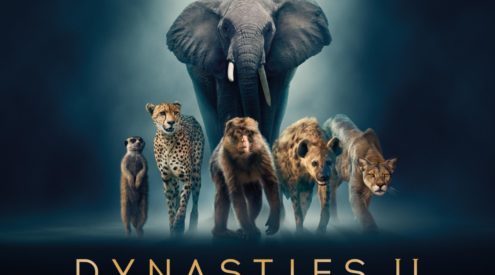Think you’ve been around long, homo sapien? Think again. Dermochelys coriacea has been around for more than 100 million years. Scott Ramsay finds himself watching the birthing process of the leatherback turtle in absolute wonderment.
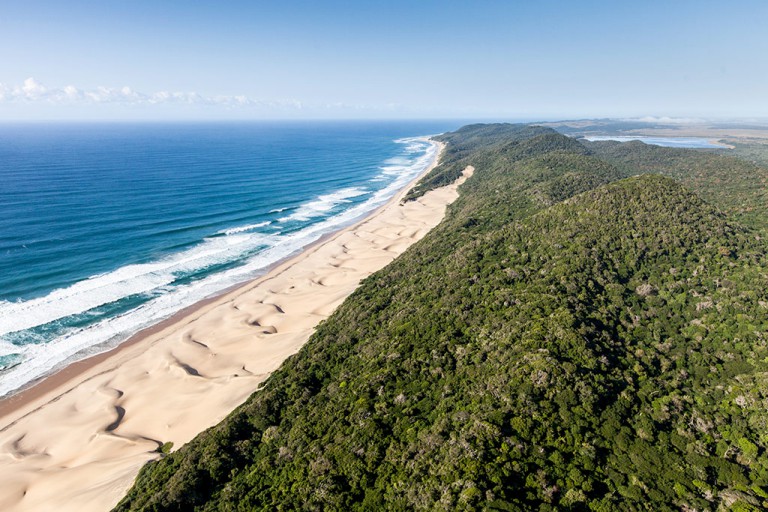
The beautiful beaches of iSimangaliso Wetland Park are flanked by the warm Indian Ocean and high, vegetated dunes covered in subtropical forest.
I felt a little embarrassed. There were six of us kneeling on the beach sand, watching a lady give birth in the dreamy light of a full moon. This lady was two metres long, weighed several hundred kilograms and had a razor-sharp beak that could slice my fingers off. Yet it still seemed a little inappropriate to be peering at her rear. The eggs came plopping out, landing in a deep hole she had dug with her flippers on the remote beach of iSimangaliso Wetland Park.
The concept of birth – be it of mammal, reptile, insect or plant – is a miraculous thing. There’s a sacredness to it that is hard to deny. But that didn’t stop us from peering. Plop, plop, plop. A few dozen eggs came tumbling out of the lady’s rear. She had clearly done this before, and maybe she’d even had homo sapiens staring up her backside before, because she seemed totally nonplussed. Plop, plop, plop. She was on a roll, and the eggs kept plopping. My embarrassment subsided a little. But then again, why would she care about a few recently evolved apes like us?
Leatherback turtles are probably first on the list of rightful inheritors of the planet. If ever there was an animal that could say: ‘I was here before you, so piss off,’ the leatherback turtle is it. Let’s stack up some numbers: anatomically modern humans have been around for about 200000 years. Leatherback turtles (Dermochelys coriacea) have been around for more than 100 million years. They were here before the dinosaurs. They were here before crocodiles. They were here before woolly mammoths. And they were here looong before the skinny legs of an upright ape came tramping along the beaches.
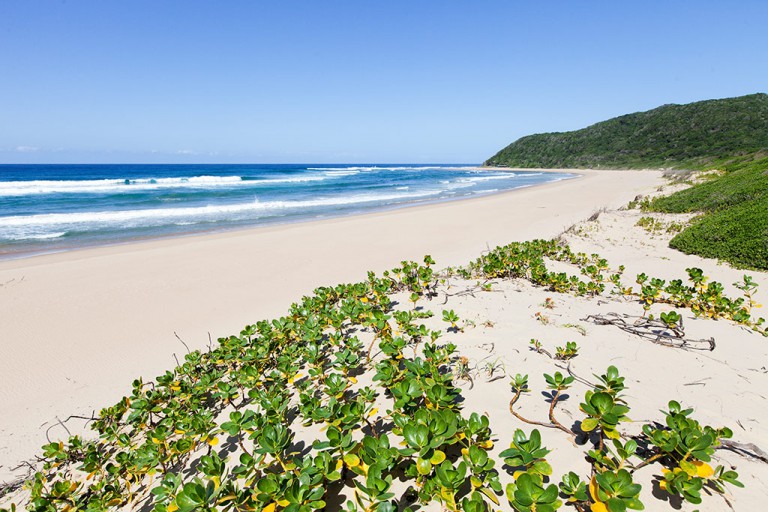
The beach at Bhanga Nek near Kosi Bay, with coastal forest and dunes and Indian Ocean.
These ancient mariners that cruise the open oceans have seen it all. Climate change, ice ages, hot ages, continental drift and several extinction events, including a big one when a huge meteor smashed into Earth 65 million years ago, setting everything on fire and wiping out 75 per cent of all species, including the dinosaurs. Leatherback turtles survived that. They are hardcore. So I shouldn’t have been embarrassed. The ancestors of our lady turtle had survived things like dinosaurs, meteors and global Armageddon – far scarier things than a group of humans watching her lay eggs. Her ancient genetic wisdom informed her that she has nothing to be worried about. Or does she?
These seemingly supreme survivors are on their way out. Leatherback turtles are now listed as a critically endangered species. That means they are on the verge of extinction, and it’s not because they’re at the end of their natural evolutionary lifespan. They swallow our plastic bags, thinking they’re jellyfish, then choke and drown. They are highly sensitive to pollution, and are often hooked and drowned by long-line and net-trawling fishing vessels. These days, there are few untrammelled beaches where they can nest safely. On most nesting beaches, their eggs and their hatchlings are destroyed by vehicles, people, dogs and unchecked development.
After 100 million years they’re disappearing, because we’re killing them. Not to eat them, mind you (their flesh is considered too oily, apparently), but because we just don’t really care. And, like the demise of rhinos, leopards, penguins, bees and vultures, that would be sad.
Besides being here long before us, leatherback turtles are simply marvellous creatures, worthy of our utmost respect. They are one of the largest reptile species and can live for an estimated 90 years. The biggest on record is more than 900 kilograms, which is heavier than some of the largest crocodiles.

A registered guide gets visitors on a turtle tour right up close to a leatherback turtle laying its eggs on the beach near Cape Vidal.
As I knelt down to take a photo, our guide Sabelo Mngomezulu estimated that our lady was about 400 kilograms, which seems miniscule in comparison, but don’t let that fool you. That’s still the combined weight – and strength – of four very large rugby players. (Sabelo told us how four turtle researchers, while trying to fit a telemetry unit to a leatherback, were once dragged helplessly along the beach when the turtle started walking back to the sea after nesting.)
I noticed how high her back stood, about a metre off the ground. (Unlike other turtle species that have hard shells, Dermochelys coriacea has a leather-like carapace.) Her tracks on the beach were about three metres wide, and her head – including that razor-sharp beak – was the size of a large man’s.
Turtles swim relentlessly, almost non-stop, all day, every day, using their hydrodynamic body shape to cruise effortlessly through the rough seas. In just a few months, they can cover several thousand kilometres across the open oceans. They can hold their breath for up to an hour, diving to more than 1000 metres below the sea (where it’s pitch black), chasing gigantic jellyfish to gobble up. This is deeper than any other large creature, besides sperm and beaked whales.
They are the fastest reptile, and can clock up a swimming speed of 35 kilometres per hour. Turtles are unique in the reptilian world, because they can maintain their own body heat. One was found to have a core body temperature of 18 degrees Celsius above the ambient water.
And here’s one lady that won’t get lost without a map. While male leatherbacks never leave the water, females will swim around the world and return to a beach near to where they hatched decades previously. They are superb navigators with supreme memories. And they seem to have a real affection for iSimangaliso’s 220 kilometres of protected beaches on the north-east coast of South Africa. Every year in November and December, about 70 of them emerge to lay their eggs in the sand, then return to the ocean.
In January and February, hundreds of hatchlings emerge and make their way down to the sea. As they scramble down the beach from their nests to the ocean for the first time, they are easy prey for honey badgers, kelp gulls, ghost grabs and raptors such as fish eagles. If they reach the sea, they need to contend with the usual suspects like game fish and sharks.
If leatherbacks manage to run the gauntlet, they still have to contend with the human factor: fishing, plastic and pollution. According to research, out of 700 eggs that a female lays annually during several nesting sessions, about 480 hatchlings emerge, and only one of these will survive to adulthood. So when you see a fully grown leatherback, such as the 400-kilogram lady at our feet, what you’re really seeing is an ultimate survivor, and the epitome of genetic refinement.
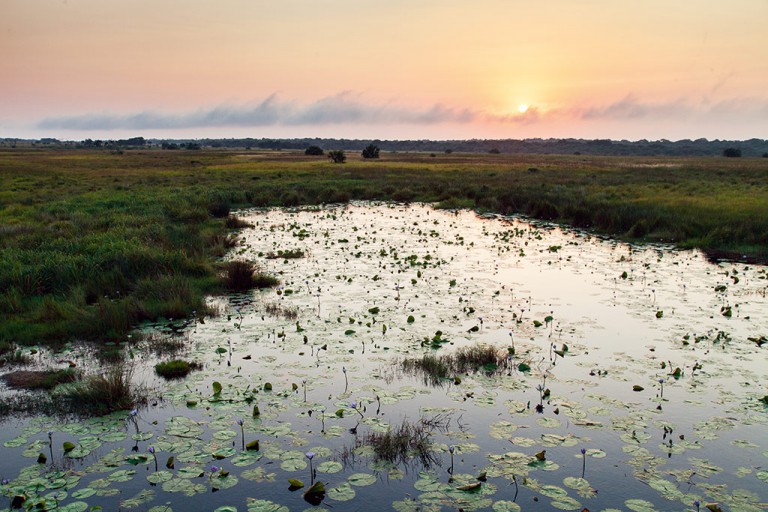
The western shores of Lake St Lucia were once covered in exotic tree plantations. After decades of restoration and rehabilitation, the grasslands, pans and lakes have returned.
The iSimangaliso Wetland Park is a paradise for leatherbacks and four other species of turtles, and it’s a haven for 3000 other types of animals, which are protected at this World Heritage Site. It seems inconceivable that this hotspot of biodiversity was almost destroyed just two decades ago, when mining companies wanted to dredge large parts of the shoreline and forested dunes for ilmenite, a mineral that is processed into titanium. This black sand conducts heat, and although it is valuable as an industrial and consumer product, it’s vital to the survival of the turtles.
‘The ilmenite in the sands is critical,’ turtle researcher Dr Ronel Nel told me. ‘The turtles have no sex chromosomes, so when they hatch in temperatures above 29 degrees Celsius, it’s a female and if the temperature is below that, it is a male. Without the ilmenite’s warmth, most hatchlings would be males, effectively dooming the population to extinction.’ Fortunately, there was a public outcry against the mining proposals and, after years of campaigning by conservationists and influential folks like former president Nelson Mandela, the iSimangaliso World Heritage site was proclaimed, banning mining forever.
The turtles could now lay their eggs in peace, knowing that they wouldn’t be disturbed. Except by a few homo sapiens on a turtle tour. Not that our lady appeared worried about the scrawny apes staring at her behind. After all, why should the wise old dame care about a bunch of evolutionary amateurs like us?
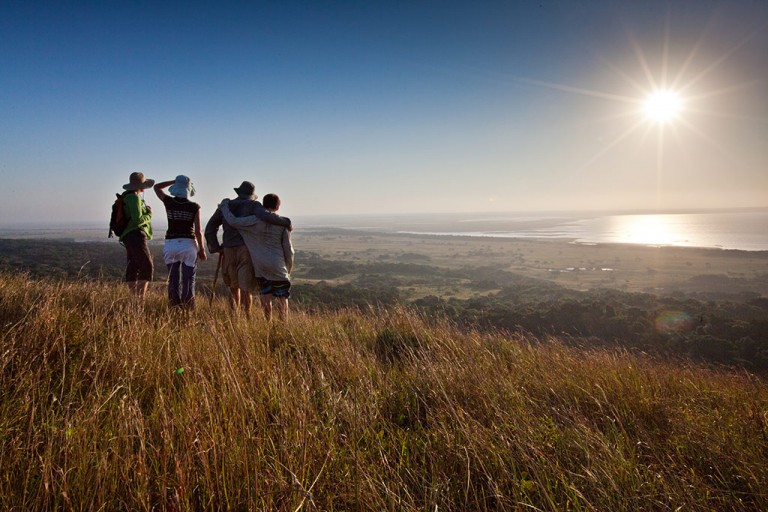
The view of Lake St Lucia from the top of the vegetated dunes on the eastern shores.
What’s so special about iSimangaliso Wetland Park?
Meaning ‘miracle and wonder’ in isiZulu, iSimangaliso is one of South Africa’s most important and beautiful protected areas. It was the country’s first World Heritage Site, declared in 1999 because of its ‘outstanding examples of ecological processes, superlative natural phenomena, scenic beauty, exceptional biodiversity and threatened species’.
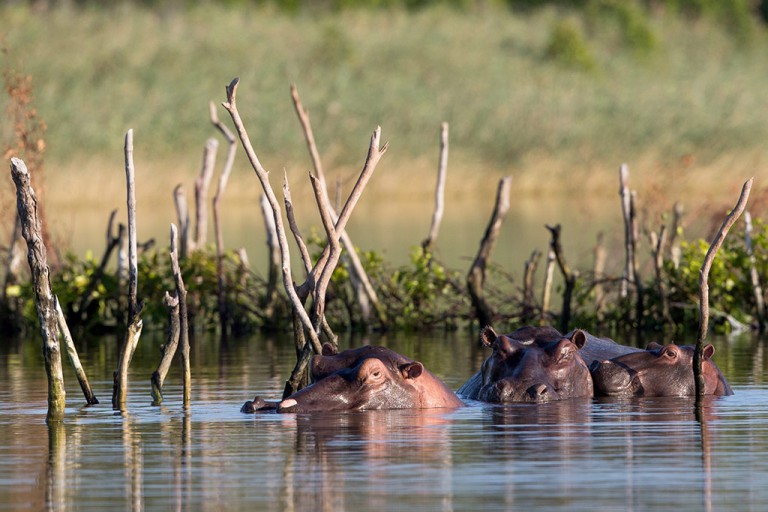
The park has one of the largest populations of hippos in the country, and they are regularly sighted in the Kosi Bay lakes in the north of the park.
Formerly Greater St Lucia Wetlands Park, this 332000-hectare stretch of land is the second-largest protected area in the country after Kruger National Park. Offshore is the 85000-hectare conservation area, consisting of the St Lucia and Maputaland Marine Protected Areas.
There are more species of animals to be found at iSimangaliso than any other protected area of Southern Africa, mainly for two reasons: the tropical climate, and the high diversity of habitats, which includes Indian Ocean coral reefs, long beaches, coastal dune forests, the country’s largest estuary (Lake St Lucia), South Africa’s biggest freshwater lake (Lake Sibaya), the country’s greatest coastal lake system (Kosi Bay), and large tracts of subtropical bushveld (Mkhuze).
It’s possible – if you time your visit correctly – to go scuba-diving among thousands of tropical fish in the morning at Sodwana Bay, photograph white rhino at Mkhuze Game Reserve by lunchtime, and that evening, watch rare loggerhead and leatherback turtles laying their precious eggs on the beaches of Kosi Bay.
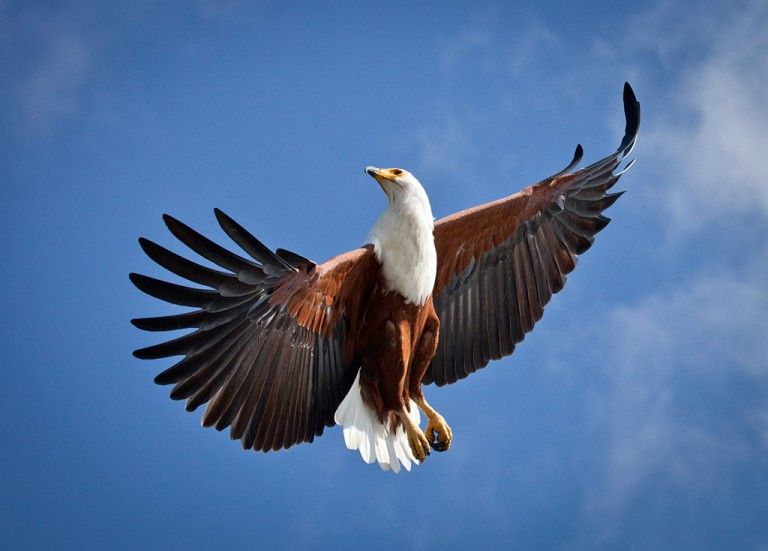
Fish eagles are common on Lake St Lucia in southern iSimangaliso.
As our former president Nelson Mandela said, ‘iSimangaliso must be the only place on the globe where the oldest land mammal (the rhinoceros) and the world’s biggest terrestrial mammal (the elephant) share an ecosystem with the world’s oldest fish (the coelacanth) and the world’s biggest marine mammal (the whale).
Plan your trip to iSimangaliso
Getting there
Drive north from Durban on the N2 for about 200km until you get to the R618. Turn right towards St Lucia. McKenzie Street, east of the town of St Lucia, will take you to the park.
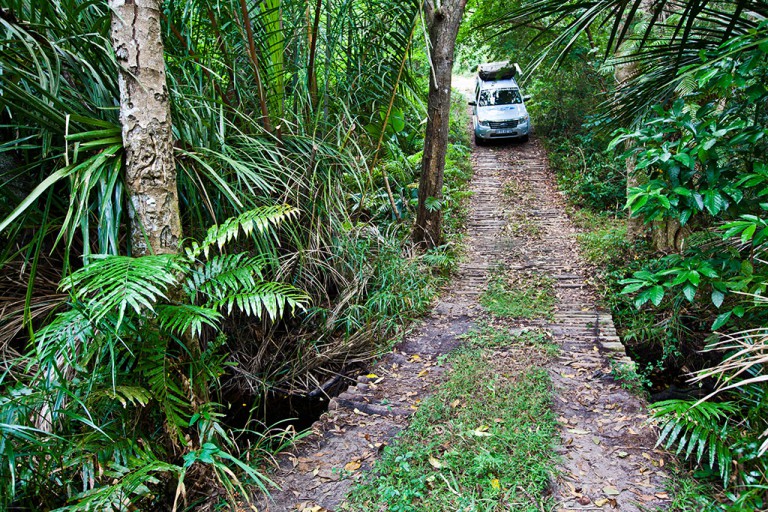
The forests near Kosi Bay are prime birding sites, especially for palm-nut vultures.
Need to know
The park comprises 10 different sections: Kosi Bay, Coastal Forest, Lake Sibaya, Sodwana Bay, Mkhuze, False Bay, Western Shores, Lake St Lucia, Eastern Shores and Maphelane. Turtles can be seen on the shoreline of Kosi Bay, Coastal Forest and Eastern Shores.
When to do a turtle tour
The best time of year to see the turtles is in summer, between October and March, when the adult females lay their eggs. Hatchlings emerge between January and April. You can only access the beaches at night with an accredited guide – it’s one of the reasons why iSimangaliso is considered a prime nesting site globally – and you’re not allowed to approach a turtle without being accompanied by a guide.
There is no guarantee of seeing turtles, but the chances are good if you go between December and February. As the tours are conducted at night (because that’s when the turtles emerge from the ocean to lay their eggs), take a head torch, a camera with flash capability, wear long pants, and take a jacket or jersey along.
Aside from lodges that offer different tours, the following operators provide trips in the area:
- Thompsons Africa Tours & Safaris R930 per person, which includes a five-hour drive and dinner on the beach. Tel 0355901584.
- Shoreline R950 per person, including a five-hour drive and dinner on the beach. Tel 0355901555.
- Ufudu Turtle Tours are in Sodwana Bay. R650 per person, which includes a four-hour drive.
Community guides in Kosi Bay, further north, are willing to take you onto the beaches near Bhanga Nek at R140 per person. Contact the following guides:
- Thembile Ngubane: Tel 0732280934
- Simangaliso Mageba: Tel 0727252738
- Shadrack Mathenjwa: Tel 0826384488
- Sthembiso Mthembu: Tel 0711546623
Where to stay in iSimangaliso
Hornbill House, in the middle of St Lucia town, is a comfortable, affordable B&B. All rooms have en-suite bathrooms, and breakfast is served on a deck overlooking the garden. From R550 per person. Owner and manager Kian Barker is a well-known naturalist and accredited guide to iSimangaliso, and offers a variety of game-drive options through the park, including an overnight turtle tour to Kosi Bay, staying at Bhanga Nek cottages (R2450 per person, including all meals).
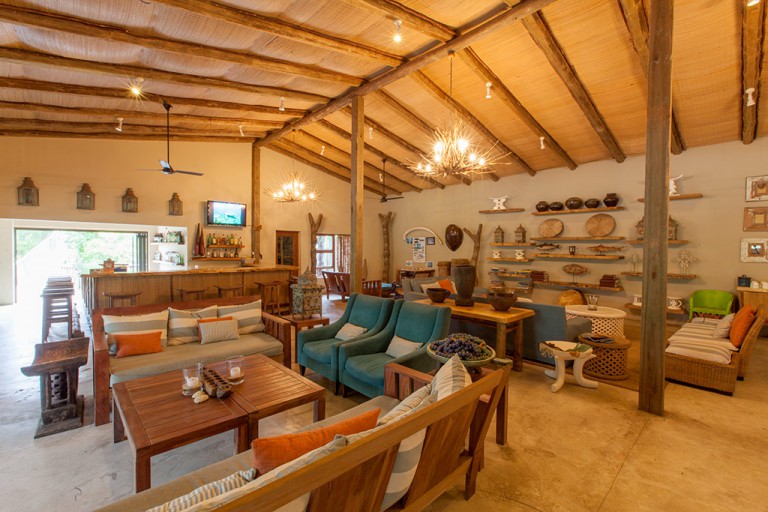
Rocktail Bay Beach Camp in the coastal forest reserve of iSimangaliso.
Rocktail Beach Camp is situated near Manzengwenya Beach in the Coastal Forest section of the park. The rooms are connected via boardwalks and about 20 minutes’ walk from the beach. Rocktail is more a semi-luxurious lodge, but it manages to combine the laid-back vibe of an upmarket backpackers with beautiful rooms, superb service and food. From R2531 per person sharing, all inclusive. Turtle tours can be arranged for R256 per person (minimum two people).
Thonga Beach Lodge is part of the Isibindi group, which has two in this area, the other being Kosi Forest Lodge. Thonga is set right on the dunes in thick, indigenous forest. Each rondavel is situated far enough apart to offer privacy, all have views of the sea, and they are connected via a wooden walkway. It’s truly special to be there, and the food is good too. From R2990 per person, including all meals and some activities. Turtle tours are an extra R540 per person.
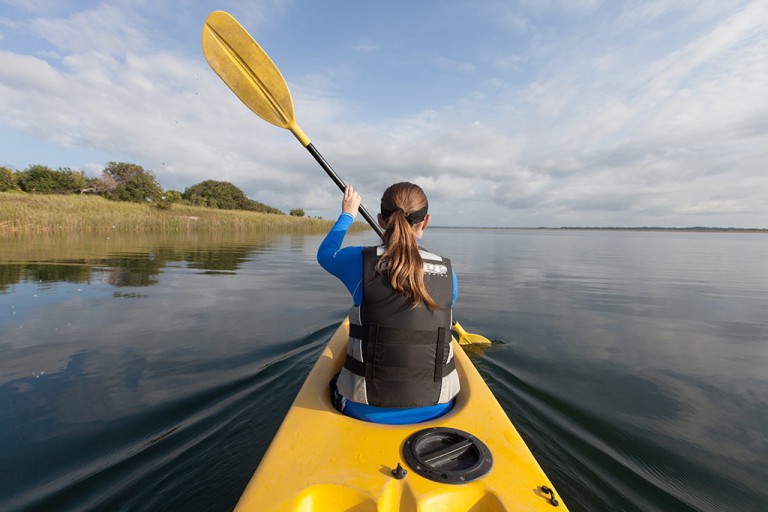
If you stay at Thonga Beach Lodge, be sure to go for a paddle on Lake Sibaya.
Kosi Forest Lodge is in the northern area of the park near Kosi Bay. The thatched/tented suites have outdoor bathrooms with the option of bathing or showering under the stars. There’s a range of activities available, including guided canoe rides or forest hikes. Rates start from R1645 per person including all meals, lake canoeing, Raffia forest walks and sundowner experiences. Turtle tours are R655 per person.
This article first appeared in the June 2015 issue of Getaway magazine.
Please note that prices are subject to change at each establishment and operator’s discretion. Be sure to check with them before travelling.
